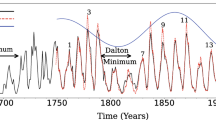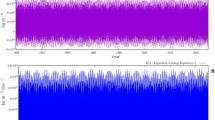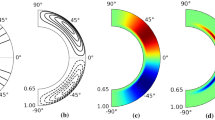Abstract
The idea of a planetary origin for the solar cycle dates back to the nineteenth century. Despite unsurmounted problems, it is still advocated by some. Stefani, Giesecke, and Weier (Solar Phys. 294, 60, 2019) thus recently proposed a scenario based on this idea. A key argument they put forward is evidence that the \(\approx 11\) years solar cycle is “clocked”, as if it were paced by an accurate clock inside the Sun. Their demonstration rests upon the computation of a ratio proposed by Dicke (Nature 276, 676, 1978) applied to the solar-cycle time series of Schove (J. Geophys. Res. 60, 127, 1955). I show that their demonstration is invalid, because the assumptions used by Schove to build his time series force a clocked behavior. I also show that instabilities in a magnetized fluid can produce fluctuation time series that are close to being clocked.




Similar content being viewed by others
Materials Availability
All matlab scripts and data used to produce the figures of this article are available as supplementary material.
References
Baidolda, F.: 2017, Search for planetary influences on solar activity. PhD thesis, Université Paris sciences et lettres. tel.archives-ouvertes.fr/tel-01690207.
Berhanu, M., Gallet, B., Monchaux, R., Bourgoin, M., Odier, P., Pinton, J.-F., Plihon, N., Volk, R., Fauve, S., Mordant, N., et al.: 2009, Bistability between a stationary and an oscillatory dynamo in a turbulent flow of liquid sodium. J. Fluid Mech. 641, 217. DOI.
Charbonneau, P.: 2022, External forcing of the solar dynamo. Front. Astron. Space Sci. 9, 853676. DOI.
Courtillot, V., Lopes, F., Le Mouël, J.: 2021, On the prediction of solar cycles. Solar Phys. 296, 21. DOI.
De Jager, C., Versteegh, G.J.: 2005, Do planetary motions drive solar variability? Solar Phys. 229, 175. DOI.
Dicke, R.: 1978, Is there a chronometer hidden deep in the Sun? Nature 276, 676. DOI.
Figueroa, A., Schaeffer, N., Nataf, H.-C., Schmitt, D.: 2013, Modes and instabilities in magnetized spherical Couette flow. J. Fluid Mech. 716, 445. DOI.
Kaplan, E., Nataf, H.-C., Schaeffer, N.: 2018, Dynamic domains of the Derviche Tourneur sodium experiment: simulations of a spherical magnetized Couette flow. Phys. Rev. Fluids 3, 034608. DOI.
Kiepenheuer, K.: 1959, The Sun, University of Michigan Press, Ann Arbor.
Malburet, J.: 1918, Sur la période des maxima d’activité solaire, Pli cacheté 8539, Acad. Sci. Paris. DOI.
Malburet, J.: 1925, Sur la cause de la périodicité des tâches solaires. L’Astronomie 39, 503. gallica.bnf.fr/ark:/12148/bpt6k9628963x/f369.item.
Malburet, J.: 2019, Sur la période des maxima d’activité solaire. C. R. Geosci. 351, 351. DOI.
Okal, E., Anderson, D.L.: 1975, On the planetary theory of sunspots. Nature 253, 511. DOI.
Okhlopkov, V.: 2016, The gravitational influence of Venus, the Earth, and Jupiter on the 11-year cycle of solar activity. Moscow Univ. Phys. Bull. 71, 440. DOI.
Scafetta, N.: 2012, Does the Sun work as a nuclear fusion amplifier of planetary tidal forcing? A proposal for a physical mechanism based on the mass-luminosity relation. J. Atmos. Solar-Terr. Phys. 81, 27. DOI.
Schmitt, D., Alboussière, T., Brito, D., Cardin, P., Gagnière, N., Jault, D., Nataf, H.-C.: 2008, Rotating spherical Couette flow in a dipolar magnetic field: experimental study of magneto-inertial waves. J. Fluid Mech. 604, 175. DOI.
Schmitt, D., Cardin, P., La Rizza, P., Nataf, H.-C.: 2013, Magneto-Coriolis waves in a spherical Couette flow experiment. Eur. J. Mech. B, Fluids 37, 10. DOI.
Schove, D.J.: 1955, The sunspot cycle, 649 BC to AD 2000. J. Geophys. Res. 60, 127. DOI.
SILSO World Data Center: 2021, The international sunspot number. International Sunspot Number Monthly Bulletin and Online Catalogue. www.sidc.be/silso/ (consulted 29 December 2021) .
Stefani, F., Giesecke, A., Weier, T.: 2019, A model of a tidally synchronized solar dynamo. Solar Phys. 294, 60. DOI.
Stefani, F., Stepanov, R., Weier, T.: 2021, Shaken and stirred: when bond meets Suess–de Vries and Gnevyshev–Ohl. Solar Phys. 296, 88. DOI.
Wood, K.: 1972, Physical sciences: sunspots and planets. Nature 240, 91. DOI.
Acknowledgments
I thank André Giesecke and Frank Stefani for providing clarifications on their computation of Dicke’s ratio. I thank my colleagues of the geodynamo team of ISTerre for useful discussions and encouragement, and an anonymous reviewer for helpful suggestions. ISTerre is part of Labex OSUG@2020 (ANR10 LABX56). This article is dedicated to Emile Okal and to the memory of Don L. Anderson.
Author information
Authors and Affiliations
Corresponding author
Ethics declarations
Conflict of Interest
The author declares that he has no conflicts of interest.
Additional information
Publisher’s Note
Springer Nature remains neutral with regard to jurisdictional claims in published maps and institutional affiliations.
Supplementary Information
Below is the link to the electronic supplementary material.
Appendices
Appendix A: Frequency Spectra of Synthetic Tidal Forcings
I have built synthetic tidal forcings to illustrate the lack of evidence for a ≈ 11.2 years periodicity, as demonstrated by Okal and Anderson (1975). I model the tidal accelerations exerted by Jupiter, Venus, Earth, and Mercury, assuming circular orbits and starting at a time when all the planets are aligned. Mass, distances and orbital periods are taken from nssdc.gsfc.nasa.gov/planetary/factsheet/.
The tidal signal of this simplified planetary system at a given meridian on the Sun can be expressed as:
where \(m_{\text{p}}\) and \(d_{\text{p}}\) are the mass and distance from the Sun of planet \(p\), respectively. \(T_{\text{p}}\) is its orbital period, while \(T_{\text{S}}\) is the duration of a solar day, taken as 27 days.
Figure 5a shows the predicted tidal signal over a period of 10,000 days (27.4 years). The orbital period of Jupiter (11.86 years) is indicated by vertical red bars. The maximum tidal forcing achieved at \(t=0\) is marked by a horizontal dashed line. It can be seen that forcings almost as large occur many times during one orbital period of Jupiter, typically each time Jupiter and Venus are aligned with the Sun.
Time series and envelope of tidal forcing as a function of time in a realistic synthetic solar system. (a) Tidal signal at a given meridian on the Sun, calculated from Equation 4 over 10,000 days (27.4 years). The periods of the four planets are marked by vertical lines of different colors. The maximum tide (achieved at \(t=0\)) is shown by a horizontal dashed black line. (b) envelope of the tidal signal. The minimum and the (second) maximum are marked by a red triangle and a blue triangle, respectively. The periods of Jupiter and Venus are shown by vertical lines. (c) Positions of the four planets at the minimum tide (\(t=1245\) days). (d) Positions of the four planets at the (second) maximum tide (\(t=8174\) days).
The tidal minima are better seen in Figure 5b, which displays the envelope of the tidal signal. The minimum of the series (at \(t=1245\) days) is marked by a blue triangle, while the second maximum (at \(t=8174\) days) is shown by a red triangle. The corresponding positions of the four planets are given in Figures 5c and 5d, respectively. As expected, all four planets are almost aligned with the Sun at the maximum, while Jupiter cancels Venus’ tide and Mercury cancels the Earth’s tide at the minimum.
Figure 6 presents the spectra of a 360-year synthetic tidal signal (blue) and of its envelope (orange). The four peaks of the former simply correspond to half a solar day as seen from each planet (see Equation 4). The spectrum of the envelope is dominated by peaks at the periods of the syzygies of pairs of planets with the Sun and their overtones. The spectrum is almost flat for periods beyond 300 days. This plot mimics Figure 3 of Okal and Anderson (1975), which shows the full tidal spectrum, “taking into account the complete orbital elements [of the four planets], including eccentricity, inclination and their variation with time” over a period of 1800 years. Orbital eccentricity adds up small tidal peaks at the orbital periods of Jupiter (11.86 years) and Mercury (0.241 years), but nothing shows up at 11.2 years (4088 days), as emphasized by Okal and Anderson (1975).
Power spectra of the tidal signal (blue) and of its envelope (orange), as a function of period. The tidal peaks of the envelope spectrum appear at syzygies of pairs of planets with the Sun. Following Okal and Anderson (1975), I label them with the initials of the two planets. The largest tide is “VJ” at 118.5 days when Venus and Jupiter are aligned with the Sun.
Appendix B: Time Series and Deviations of Synthetic Solar Maxima
Figures 7 and 8 display the time series and deviations of the synthetic solar cycles that comply with Schove’s assumptions, for comparison with Figure 1 of Stefani, Giesecke, and Weier (2019). Deviations of each realization are the difference between dates of the maxima and a linear fit of these dates.
(a) Time series and (b) deviations of Schove-compliant random-walk synthetic solar cycles (three lines of different colors). The blue squares are for Schove’s maxima before 1755 and from SILSO World Data Center (2021) after 1755.
(a) Time series and (b) deviations of Schove-compliant clocked synthetic solar cycles (42 lines of different colors). The blue squares are for Schove’s maxima before 1755 and from SILSO World Data Center (2021) after 1755.
Appendix C: Dicke’s Ratio of Magnetic Fluctuations in the DTS\(\Omega \) Experiment
The DTS\(\Omega \) experiment was built to study magnetohydrodynamics in the magnetostrophic regime, in which Lorentz and Coriolis forces are dominant. Fifty liters of liquid sodium are enclosed in a spherical container that can rotate around a vertical axis. An inner central sphere can rotate independently around the same axis and hosts a strong permanent magnet producing an axial dipolar magnetic field. The three components of the induced magnetic field are measured at the surface of the outer sphere at 20 equally spaced latitudes from \(-57^{\circ}\) to \(57^{\circ}\) (see Schmitt et al. (2013) for more details). The frequency spectra of the electric and magnetic fluctuations reveal a quasi-periodic behavior that can be linked to the presence of magneto-Coriolis waves (Schmitt et al., 2008, 2013) or instabilities (Figueroa et al., 2013; Kaplan, Nataf, and Schaeffer, 2018).
An example of such quasi-periodic magnetic fluctuations is given in Figure 9. The spin rate of the outer sphere is \(f_{o} \approx 10\) Hz, while the differential rotation of the inner sphere is \(\Delta f \approx -20\) Hz, yielding fluid velocities \(U \approx 25\) m s−1. With an outer radius \(r_{o} = 0.21\) m, the Reynolds number \(Re = \frac{U r_{o}}{\nu} \approx 8 \times 10^{6}\) and the magnetic Reynolds number \(Rm = \frac{U r_{o}}{\eta} \approx 60\), where \(\nu \) is the kinematic viscosity, and \(\eta \) is the magnetic diffusivity. Figure 9a displays a latitude-versus-time color-coded image of the squared azimuthal magnetic fluctuations averaged over one turn of the inner sphere, in a time-window of some 250 rotations of the inner sphere. Latitudinally coherent quasi-periodic fluctuations of variable intensity dominate. Figure 9b is the time record of the same fluctuations at a latitude of \(9^{\circ}\). I have extracted the 100 maxima from this record, plotted as triangles in Figure 9b. The duration between maxima is \(0.11 \pm 0.03\) seconds. Dicke’s ratio of the resulting time series is plotted in Figure 4, together with Dicke’s ratio of the previous and next series of 100 maxima. All three series appear to be closer to clocked behavior than to random-walk behavior.
Magnetic fluctuations in the DTS\(\Omega \) experiment. (a) Color-coded image of the square of the azimuthal magnetic-field fluctuations normalized by the square of the imposed magnetic field [%] at the surface of the outer sphere. The magnetic field is measured at the 20 latitudes which form the \(y\)-axis. The \(x\)-axis is time given in number of turns of the inner sphere with respect to the outer sphere. The records are averaged over one such differential turn. (b) Extraction of the same signals at a latitude of \(9^{\circ}\), showing a succession of peaks labelled by magenta triangles.
Rights and permissions
Springer Nature or its licensor (e.g. a society or other partner) holds exclusive rights to this article under a publishing agreement with the author(s) or other rightsholder(s); author self-archiving of the accepted manuscript version of this article is solely governed by the terms of such publishing agreement and applicable law.
About this article
Cite this article
Nataf, HC. Tidally Synchronized Solar Dynamo: A Rebuttal. Sol Phys 297, 107 (2022). https://doi.org/10.1007/s11207-022-02038-w
Received:
Accepted:
Published:
DOI: https://doi.org/10.1007/s11207-022-02038-w









